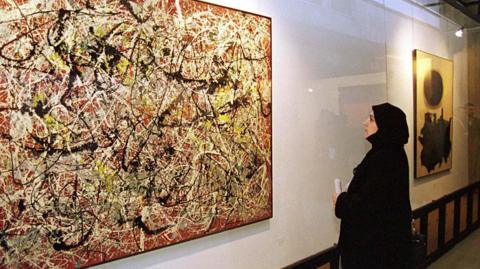Exploring the Hidden Treasures: Masterful Artworks of Picasso and Pollock in Tehran’s Vault
The collection includes Jackson Pollock’s Mural On Indian Red Ground.
It has been dubbed one of the world’s rarest treasure troves of art but few people outside its host country know about it. For decades, masterpieces by the likes of Pablo Picasso, Vincent Van Gogh, Andy Warhol and Jackson Pollock have been kept in the basement of a museum in Iran’s capital Tehran, shrouded in mystery.

According to estimates from 2018, the collection is worth as much as $3 billion. Only a small portion of this work has been exhibited since the 1979 Iranian Revolution but recently, there have been attempts to showcase some of its most captivating pieces at the Tehran Museum of Contemporary Art.

The Eye to Eye exhibition at the museum opened in October 2024 and was extended twice due to overwhelming public demand, running until January 2025. This display is widely regarded as one of the most significant exhibitions in the history of the museum and also its most visited. The showcase featured more than 15 works unveiled for the first time, including a sculpture by Jean Dubuffet – marking its debut appearance at an Iranian exhibition.

Some other notable pieces include Warhol’s portrait of Farah Pahlavi – Iran’s last queen – which blends his pop art flair with Iranian cultural history. Additionally, there is Francis Bacon’s work called Two Figures Lying on a Bed with Attendants, where figures seem to be spying on two naked men lying on the bed.

Opposite this artwork in the basement of the museum hangs a portrait of Ayatollah Ruhollah Khomeini, the founder of the Islamic Republic of Iran. This juxtaposition highlights both high and low points in Iranian cultural history.

The Tehran Museum was built in 1977 under the patronage of Pahlavi, exiled widow of the last Shah who was overthrown during the revolution. Kamran Diba, an architect from her cousin’s family, designed this museum intended to introduce modern art to Iranians and bridge Iran closer to the international art scene.

Upon its completion, it became home to stunning works by luminaries like Picasso, Warhol, Salvador Dal as well as leading Iranian modernists. The museum quickly established itself as a beacon for cultural exchange and artistic ambition. However, after the 1979 revolution that turned Iran into an Islamic republic with clerical political control under Ayatollah Khomeini, many artworks deemed inappropriate due to nudity or religious sensitivities were locked away in a basement.

Only towards late 1990s did this collection reclaim its cultural significance. This was during the reformist presidency of Mohammad Khatami when international art world suddenly remembered what it had been missing: works by Van Gogh, Dali and even Monet all within Tehrans borders. Some pieces were loaned to major exhibitions in Europe and the US for brief periods.

Art historian Hamid Keshmirshekan based in London who has studied this collection refers to it as “one of the rarest treasure troves of modern art outside the West”. This prestigious group includes Henry Moore’s Reclining Figure series, a vibrant piece by one of Britains celebrated sculptors; Jackson Pollocks Mural on Indian Red Ground, an energetic and emotionally charged painting technique. Picasso’s The Painter and His Model from 1927 is another notable work in the collection.
Unfortunately for art lovers based in Britain, this remarkable trove remains out of reach due to travel advisories issued by UK Foreign Office warning against all journeys to Iran. It also advises that British and dual nationals face significant risks including arrest or detention simply because they hold a British passport or have connections with the UK.
The Tehran Museum continues its unique role as an unlikely guardian of modern art masterpieces in heart of Tehran, operating under tight budgets due to shifting political priorities which often prioritize it more as cultural hub than traditional museum.

